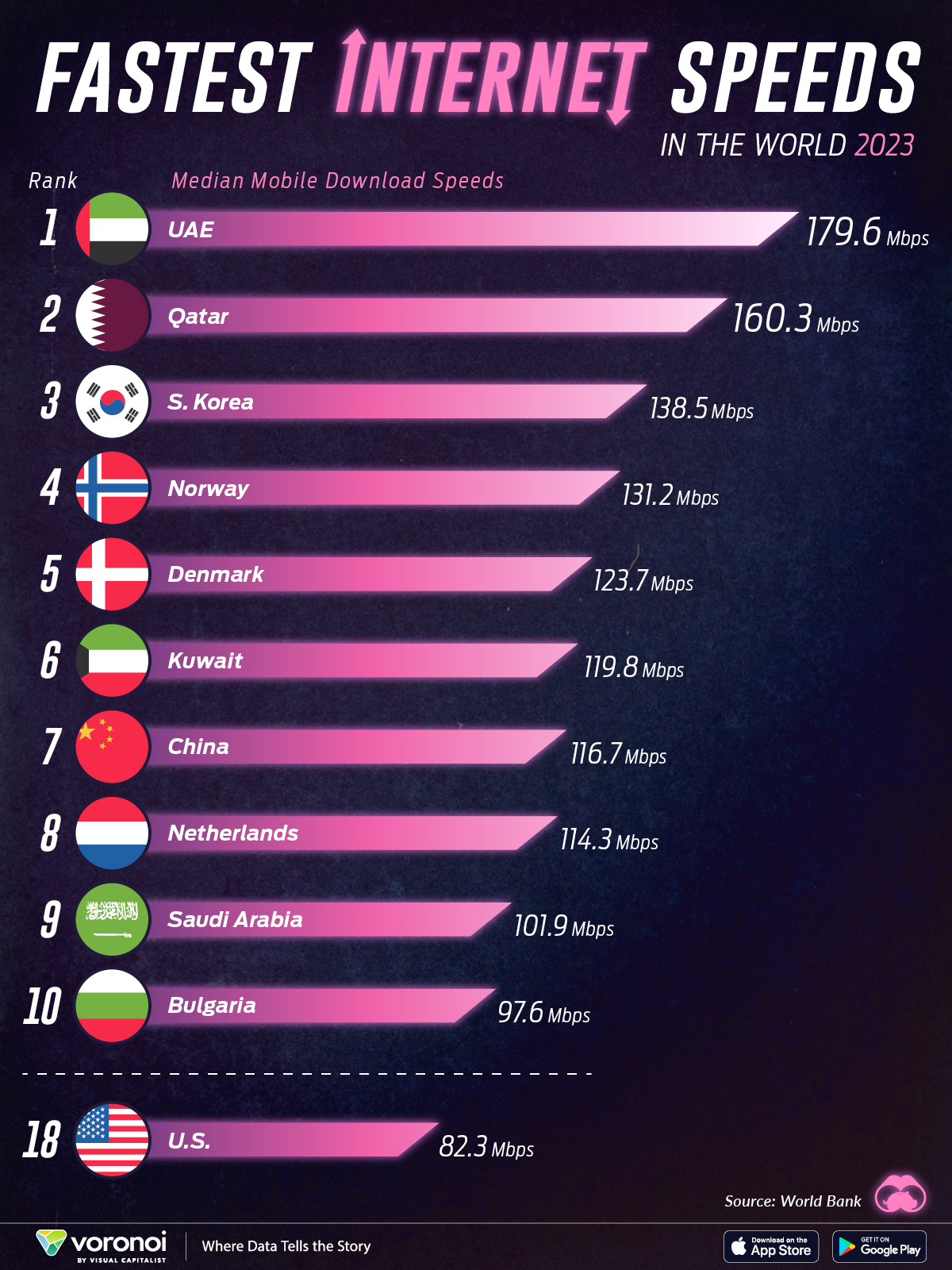Now Reading: Top 10 best Countries with the Fastest Internet
-
01
Top 10 best Countries with the Fastest Internet
Top 10 best Countries with the Fastest Internet

Speed is the New Standard
In today’s hyper-connected world, fast mobile internet isn’t just a luxury—it’s a necessity. Whether it’s streaming videos, attending virtual meetings, or navigating real-time maps, speed directly impacts user experience. According to the latest data from Ookla’s Speedtest Global Index, mobile internet in 2024 has hit new benchmarks across several nations.
In this post, we’ll explore the top 10 countries with the fastest mobile internet in 2024, the reasons behind their success, and what this means for global digital development.
What Defines Fast Mobile Internet?
Before diving into the rankings, it’s important to understand how mobile internet speed is measured. Typically, it’s evaluated by:
- Download speed (Mbps)
- Upload speed (Mbps)
- Latency (ms)
These metrics determine how efficiently a mobile network supports activities like gaming, video calls, and cloud-based work.
Top 10 Countries with the Fastest Mobile Internet in 2024
Let’s explore the nations that are leading the pack in mobile internet in 2024, based on average download speeds reported by Ookla.
1. United Arab Emirates (UAE)
Average Speed: 314 Mbps
The UAE has consistently topped the charts due to aggressive 5G rollout, strong telecom regulation, and high smartphone penetration.
2. Qatar
Average Speed: 298 Mbps
With continuous investment in 5G infrastructure and digital initiatives, Qatar maintains its position near the top.
3. South Korea
Average Speed: 280 Mbps
Known for its tech-forward population and early 5G adoption, South Korea continues to deliver impressive speeds.
4. Norway
Average Speed: 265 Mbps
Norway blends urban 5G networks with excellent coverage in rural areas, offering consistently fast mobile data.
5. Saudi Arabia
Average Speed: 249 Mbps
The country’s Vision 2030 plan includes major investments in digital infrastructure, boosting mobile network performance.
6. China
Average Speed: 240 Mbps
China’s state-backed 5G expansion has made high-speed mobile internet accessible across major cities and beyond.
7. Netherlands
Average Speed: 234 Mbps
High competition among providers and a tech-savvy population keep mobile speeds among the fastest in Europe.
8. Switzerland
Average Speed: 228 Mbps
With exceptional service quality and widespread 5G access, Switzerland remains a global connectivity leader.
9. Denmark
Average Speed: 223 Mbps
Focused on digital innovation and sustainability, Denmark boasts one of the most efficient telecom networks.
10. Singapore
Average Speed: 217 Mbps
A compact geography and heavy investment in next-gen networks have secured Singapore a spot in the top 10.
Why Are These Countries Leading?
Cutting-Edge Infrastructure
These countries have prioritized 5G deployment, fiber-optic backbones, and high-density small-cell networks to ensure maximum speed and coverage.
Regulatory Support
Governments in these regions often work hand-in-hand with telecom providers to remove barriers, fund innovation, and streamline spectrum allocation.
Competitive Markets
A high number of mobile service providers creates a competitive landscape, leading to better service and innovation for consumers.
Global Trends in Mobile Internet in 2024
The Rise of 5G
By mid-2024, over 60% of mobile traffic globally runs on 5G networks. This shift has drastically improved both speed and reliability in urban areas.
Increasing Data Consumption
Average monthly mobile data usage per person has climbed to 20GB in leading countries, driven by HD streaming, remote work, and gaming.
Focus on Rural Connectivity
Governments and private firms are working to close the urban-rural gap. Initiatives like Starlink and local 5G towers are making strides in underserved regions.
How Does Your Country Compare?
Even if your country didn’t make the top 10, there’s still good news. Mobile internet speeds are improving worldwide, thanks to growing investments in infrastructure and innovation.
To see where your country ranks, check out the Speedtest Global Index. You can also explore our guide on improving mobile internet performance for individual users.
What This Means for You
Whether you’re a digital nomad, gamer, entrepreneur, or casual browser, fast mobile internet impacts your daily life. Countries leading in mobile internet in 2024 offer lessons in innovation, investment, and strategy.
If your country is still catching up, it’s an opportunity for policymakers and telecom companies to raise the bar.
Related Reading
- How 5G Is Reshaping the Global Economy
- Top 5 Tools to Test Your Mobile Internet Speed
- Building Resilient Connectivity in Rural Areas
Final Thoughts: Speed is Power
As mobile devices become our main gateway to the internet, mobile internet in 2024 has emerged as a key indicator of national digital health. The top-performing countries are not just offering faster internet—they’re enabling innovation, economic growth, and social inclusion.





















